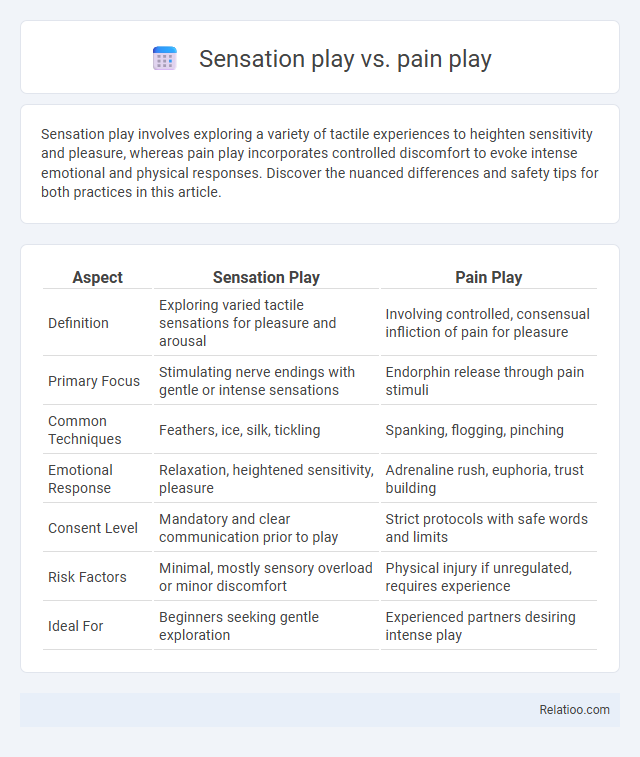Sensation play involves exploring a variety of tactile experiences to heighten sensitivity and pleasure, whereas pain play incorporates controlled discomfort to evoke intense emotional and physical responses. Discover the nuanced differences and safety tips for both practices in this article.
Table of Comparison
| Aspect | Sensation Play | Pain Play |
|---|---|---|
| Definition | Exploring varied tactile sensations for pleasure and arousal | Involving controlled, consensual infliction of pain for pleasure |
| Primary Focus | Stimulating nerve endings with gentle or intense sensations | Endorphin release through pain stimuli |
| Common Techniques | Feathers, ice, silk, tickling | Spanking, flogging, pinching |
| Emotional Response | Relaxation, heightened sensitivity, pleasure | Adrenaline rush, euphoria, trust building |
| Consent Level | Mandatory and clear communication prior to play | Strict protocols with safe words and limits |
| Risk Factors | Minimal, mostly sensory overload or minor discomfort | Physical injury if unregulated, requires experience |
| Ideal For | Beginners seeking gentle exploration | Experienced partners desiring intense play |
Understanding Sensation Play vs Pain Play
Understanding sensation play versus pain play involves recognizing that sensation play emphasizes a variety of tactile experiences designed to stimulate the senses without causing harm, often using feathers, ice, or silk. Pain play focuses on controlled, consensual experiences that explore the threshold of pain to elicit intense physical and emotional responses, involving activities like spanking or using impact tools. Both practices rely heavily on communication, consent, and safety protocols to ensure a positive and respectful experience for all participants.
Defining Sensation Play: Exploring the Senses
Sensation play involves stimulating the senses through gentle or varied tactile experiences, emphasizing textures, temperatures, and light touches to heighten awareness and pleasure. Pain play, by contrast, centers on controlled discomfort or pain to trigger endorphin release, often creating intense physical and emotional sensations. Exploring sensation play offers a nuanced approach to sensory exploration, focusing on non-painful stimuli that enhance physical connection and mindfulness.
What is Pain Play? Basics and Appeal
Pain play involves consensual activities that introduce controlled physical discomfort or pain for heightened sensory experience and emotional release. It is distinguished from sensation play by the deliberate use of pain stimuli such as spanking, biting, or impact play to explore boundaries and intensify pleasure. Enthusiasts often find appeal in the psychological thrill, the endorphin rush, and the deep trust required between participants.
Key Differences Between Sensation and Pain Play
Sensation play focuses on stimulating the skin and senses using gentle touches, textures, or temperature variations to evoke pleasurable or heightened sensory experiences, whereas pain play involves the intentional application of controlled pain stimuli to elicit intense physical and psychological responses. The key difference lies in the participant's perception and threshold, with sensation play prioritizing comfort and exploration of tactile sensations, while pain play tests limits through consensual discomfort or pain. Both practices require clear communication, trust, and consent to ensure safety and enjoyment within BDSM contexts.
Common Tools and Techniques for Sensation Play
Common tools for sensation play include feathers, silk scarves, ice cubes, and massage oils to create a variety of tactile experiences that stimulate your skin without pain. Techniques often involve gentle stroking, light tapping, or temperature play to heighten sensitivity and enhance pleasure. Unlike pain play, which uses impact tools like floggers or paddles to inflict controlled discomfort, sensation play focuses on a broader range of textures and sensations to engage the senses.
Popular Practices in Pain Play
Popular practices in pain play include spanking, flogging, caning, and using pinwheels or clamps to elicit controlled discomfort and heightened sensation. Sensation play, contrasting with pain play, emphasizes gentle stimulation techniques like feather tickling, ice cubes, or light massage to awaken your sensory experience without pain. Understanding the differences allows you to explore boundaries safely while tailoring activities to your preferences and limits.
Safety and Consent in Sensation and Pain Play
Sensation play and pain play involve different intensities of physical stimuli, where sensation play uses gentle touches to stimulate the senses, and pain play incorporates controlled discomfort to elicit specific responses. Safety and consent are paramount in both practices; you must establish clear boundaries, use safe words, and maintain open communication to ensure a positive and respectful experience. Prioritizing informed consent and monitoring physical and emotional reactions reduce the risk of injury and enhance trust between participants.
Psychological Benefits and Emotional Effects
Sensation play, pain play, and combined sensation-pain play each offer distinct psychological benefits and emotional effects, enhancing Your intimacy and self-awareness. Sensation play emphasizes varied tactile experiences that promote relaxation, heightened sensory perception, and emotional bonding, while pain play can trigger endorphin release, leading to stress relief, empowerment, and emotional catharsis. Merging both modalities deepens trust and vulnerability, fostering emotional resilience and a stronger psychological connection between partners.
Communication Tips for Partners Exploring Play
Effective communication is essential when exploring sensation play, pain play, or a combination of both to ensure safety and mutual enjoyment. Partners should establish clear boundaries, use consent signals like safe words, and continuously check in to respect each other's comfort levels. Your openness and honesty during these conversations build trust and enhance the experience while minimizing misunderstandings.
Finding What’s Right for You: Sensation or Pain Play
Finding what's right for you involves understanding the distinctions between sensation play and pain play, as sensation play emphasizes gentle, teasing stimuli such as feathers or light touches, while pain play incorporates controlled, consensual discomfort like spanking or pinching. Your preferences depend on your comfort level and boundaries, with sensation play often serving as a gateway to explore sensitivity and arousal without intense physical stress. Experimenting mindfully with both forms can help you discover a balance that enhances your intimate experiences while prioritizing safety and consent.

Infographic: Sensation play vs Pain play
 relatioo.com
relatioo.com